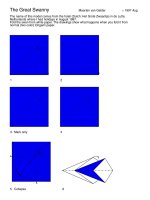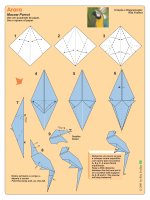Tài liệu Fruge drawing - Figure Notation in Deep Space pdf
Bạn đang xem bản rút gọn của tài liệu. Xem và tải ngay bản đầy đủ của tài liệu tại đây (3.05 MB, 20 trang )
)LJXUH1RWDWLRQLQ
'HHS6SDFH
In Chapter we attempted to show the major
body forms as shape-masses, conceiving them
according to their differences as VROLGREMHFWVLQ
VSDFH This means that we have tried to define
form as three dimensional volume, not simply
as flat body silhouette.
Seeing the body as a flat silhouette
encourages a simplistic description of the figure
as a mere DUHD and a drawing of this flat shape
commonly assumes the character of an outline,
or contour, drawing only. Shape-mass, on the
other hand, demands to be understood as
volume structure in three dimensions;
this makes it poss ib le to draw the figure in deep
space projections, putting the human form into
the most inventive and varied conceptions of
foreshortening, advancing and receding in
space.
Conceiving the figure as shape-mass permits
the artist to manipulate the figure creatively,
part by part, making changes according to his
desire, ZLWKRXW FRS\LQJ or using file reference
materia l. Like a sculptor working w ith modeling
clay, the artist can structure and compose by
building-up. He can alter the actions and
projections of separate forms. He can revise and
modify his
forms at will. But more important, he can
choose to introduce radical innovations of form,
To do this, at least experimentally, the artist
must approach his drawing with a QHZRUGHURI
IRUP He must give up certain uncritical
conventions and preconceived notions of figure
drawing. For instance, he must put aside
starting the figure by sketching in the head. He
must give this up, firmly. According to the
method which I propose, the WRUVRabove any
other form, is of primary importance. With this
premise, let us initiate the new order of form
and assert the opening rule. . .
7KH 7R UVRLV3ULPDU\
The reason for this statement will become clear
after a few exploratory sketches have been
made, and when we work out the following
propositions. 7KH WRUVR PDVV LV WKH FHQWUDO
GRXEOH IRUP WR ZKLFK DOO RWKHU IRUPV DWWDFK
Any movement in the upper or lower torso will
immediately throw the secondary forms—the
legs, arms, and head—out of their previous
positions and into a new relationship.
Here are four structured torsos, showing the
ease with which figure notation may be
indicated in a sequence of movements from left
to right, front to back. It must be obvious now
why the double
torso mass is instrumental. The merest
movement of the rib barrel produces an
immediate displacement of arms and head,
while a pelvic shift compe ls total dep loyment
of all the body forms.
An important drawing aid, in accommodating
the changes of direction in the two-part torso, is
the FHQWHU OL QH of the body. In this two-stage
drawing, the primary torso masses are on the
left, the completed figure on the right. Of
crucial interest here is the insertion of the
midline in both figures. Notice how this
midline, or center line, gives unity and direction
to the independent movements of the separate
masses (right).
In movement, the separate torso masses need
not face in the same direction. The midline
insertion can produce RSSRVLWLRQ between the
upper and lower forms. The clue to this
opposition is the VSLUDO or S-line connection.
Starting with a simple bend only (figure on
extreme left), this series of torsos shows an 5-
line spira l insert ion express in g a swivel, or
twist, between the contrary views of the body
masses: the rib barrel view on one side, the
pelvic wedge pivoting to the opposite side
(below).
46
A series of figure variations showing the
correlated and contrary directions of the torso
masses, using the midline insertion connection.
Legs, arms, and head have been added here to
show how the torso, as the primary figure form,
governs the positioning of the secondary parts.
7KH/HJVDUH6HFRQGDU\
We have stated the necessity of using a new
order of form in drawing the figure in deep
space. Our initial assertion has been that the
torso is first in importance. Following the
primary torso masses in this notational order, our
rule proposes that WKHOHJVDUHVHFRQGDU\
The reason that the legs QRW the arms) come
after the torso masses is that the figure, in
whatever action it takes, is for the most part
related to the ground plane. It works against the
pull of gravity, expressing weight, pressure, and
tension; it needs leg support to sustain it.
Without this support, the figure may not be able
to project a convincing demonstration of
exertion, effort, and dynamism. This fact also
calls for a more emphatic use of the pelvic
wedge than has previously been discussed.
When the torso forms have been sketched in, the
pelvic wedge must be clarified as to structure
and direction, with the midline div ision well la id
in so that the legs can be given their relevant
attachment.
In this figure, the upper rib cage barrel has been
lightly indicated. The lower torso (the pelvic
wedge) on the other hand, has been explicitly
defined, with the legs set into each side of it.
This series of figures shows the wedge block of
the pelvis in it iatin g the attachment of the legs.
Notice how the cylindrical thigh form of the
upper leg enters the pelvic mass well below its
box-like front comer.
When we attach the legs to the sides of the
pelvic wedge block, note the large, protruding
secondary form, the centrally located lower
belly (actually the mass of the small intestine),
which is encased in the hollow of the pelvic
basin. The figure to the left shows a
schematized version of the bulging belly box
mounted in the opening of the hip flanges. The
center figure relates this belly bulge to the legs.
Notice how the legs, entering the hips, tend to
squeeze
the base of the belly. Because of the apparent
pressure, the belly rises high in the basin. The
figure to the right emphasizes the high belly
insert in an action figure: when the legs move,
the wedge may spread to accommodate the
change of position. The round protru sion,
high in the sides of the legs, is the great
trochanter, the bony eminence which lets us
see the origin of the leg as it swivels, bound
yet free, in the socket of the hip.
Let us review the structure rhythms of the leg.
In the small, erect figure to the left, the front leg
is characterized by a B-shape. The side leg (in a
raised bend position) has an S-curve line. (Both
rhythms are shown in the dotted lines.) The
large, center figure faces left with both legs in a
side view position which are expressed with S-
curve notation
lines. The two figures to the right show how the
side view leg is easily interpreted in both front
and back positions. The upper figure presents a
front view leg in a deep bend, which is
described with a B-shape curve. In this case,
notice that the upper leg is shown with the WRS
section of the B-shape IROGHG EDFNZDUG as the
knee bends back.
No discussion of the leg would be complete
without noting the stance of the feet and their
relationship as support platforms to the pillars
of the legs. In this front view leg, notice how the
entire length of the leg thrusts LQZDUG from the
high, outside hip projection to the low, inner
ankle projection VHH long leg arrow). The foot
stance is shown in the dotted ellipse. Note the
thrust of the foot as the ankle connection
reverses the bearing of the leg and thrusts the
support direction of the foot RXWZDUG (see short
foot arrow).
This series of action figures allows to see
the stance of the foot from number of
viewing angles. Observe how the foot
arrow thrusts RXWZDUGfrom the ankle to
produce the correct foot stance (below).
We have mentioned the enormous
flexibility of the two body masses the torso,
which effect extreme move ment in the
mid-axial connection the waist. When the
body weaves sways, or gyrates, it is
important give the leg pillars an effective a
convincing support. In the figure the right—
a multiple action torso the front legs are
underpinned with RXWWKUXVW foot stance
support. (Note how the long leg arrows
reverse at the ankle, then bear the foot
stance in outward direction from the leg.)









